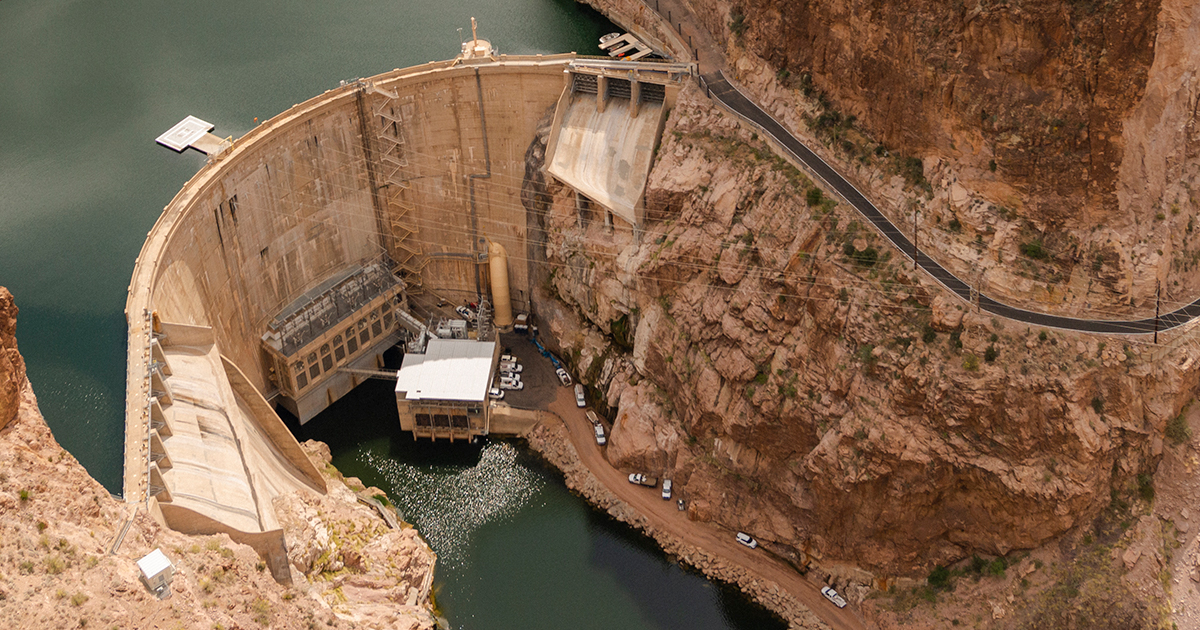
Managing water in the desert
SRP has provided water to the Valley for more than a century, and we work every day to ensure a sustainable water supply that will last for generations to come.
On this page:
On related pages:
Did you know that Greater Phoenix has been going through a drought since the mid-1990s? And yet, the area continues to thrive.
That’s because SRP and our partner organizations are putting research and innovation to work to safeguard Arizona’s water for today and tomorrow. SRP has also worked closely with Arizona State University to create the Arizona Water Blueprint
.
Managing drought is one of the reasons SRP was formed. We have a history of planning and managing the Valley's water to ensure a reliable supply for the future, even in a changing climate.
Drought cycles are normal for our arid region
Studies of tree rings provide long-term historical insights into the duration and severity of regional droughts and show that long dry periods with sporadic “spike years” are normal.
For example, the current drought cycle started in the mid-1990s, and is reportedly the most severe in over twelve hundred years. A wet winter in 2017 increased SRP’s year-over-year storage by nearly 20% to over three-quarters full. After the dry year that followed, reservoir storage fell to below half by the following October: 46% full. By April of 2020, the reservoir system was again 98% full.
The purpose of surface water management is to capture streamflow in wet years for delivery and use in subsequent dry years; you can find current water levels at watershedconnection.com.
Preparing to weather Arizona drought conditions
Will we run out of water? In short – no.
Drought and water shortages are inevitable (we live in a desert, after all). But because we know and plan for this, Greater Phoenix doesn’t have to worry about not having enough water.
By tracking and planning for Arizona drought conditions, we can maintain a reliable water supply now and into the future.

See how we’re safeguarding Arizona’s water supply and how you can help us conserve.
Building a water supply that’s drought-proof
Explore the latest water management and conservation efforts we’re leading to maintain a safe, reliable and resilient water supply for generations to come.
Our 2035 Sustainability Goals include six distinct targets to ensure water resiliency.
Capturing and storing water underground
In addition to the water stored in the seven reservoirs that we manage, SRP has developed two underground storage facilities.
The Granite Reef Underground Storage Project (GRUSP) and the New River-Agua Fria River Underground Storage Project (NAUSP) store water in large underground aquifers, a process known as water banking.
Water banking involves storing water in an aquifer, or a porous layer of underground rock that can hold and release water.
During wet years, extra water is stored underground. That way, during dry years, the Valley is ready with enough water.

How underground water banking works
Extra water is fed from SRP’s canals into a large, porous basin where it can seep down into the aquifer below. When the water is needed, one of our nearby wells is used to pump it back up to the surface. At SRP, we regularly adjust how much water we pump from our wells based on how full our lakes are.
Monitoring water quality
As a raw water provider, SRP delivers nonpotable water to municipal water providers and treatment plants who treat the water before it is delivered to homes, schools and businesses. We also deliver nonpotable water to agricultural, residential and commercial irrigation customers. As part of our efforts to maintain a resilient water supply, we monitor the water quality of the rivers in our watersheds, as well as the water quality in our canals and from our groundwater wells in our service area.
What we do:
- Obtain permits and approvals as required by the Clean Water Act
and the Arizona Aquifer Protection Program
.
- Collect water quality samples from points along the rivers and canals and from our groundwater wells. Samples are tested at our lab, which is certified by the state of Arizona.
- Use computer modeling to track water quality conditions in SRP's water delivery system.
For questions about your tap water, contact your municipality or potable water provider.
Per- and polyfluoroalkyl substances (PFAS):
The U.S. Environmental Protection Agency (EPA) is addressing the presence of per- and polyfluoroalkyl substances (PFAS) in the environment and has proposed regulations for drinking water. PFAS are a group of chemicals found in many consumer and industrial products. Because PFAS are widely used and break down very slowly, they have been measured in water, air, fish and soil throughout the U.S., including within Arizona. Scientific studies have shown that exposure to some PFAS may be linked to harmful health effects in humans and animals.
As a raw water provider, SRP delivers nonpotable water to municipal water providers and treatment plants. Municipal water providers treat the water to meet drinking water quality standards before delivering it to end users.
SRP proactively tracks activities related to emerging contaminants, including the EPA’s actions to set national drinking water standards for PFAS, and supports efforts to better understand impacts to the Valley’s drinking water supply and treatment options.
For more information:
- U.S. Environmental Protection Agency: Per- and Polyfluoroalkyl Substances (PFAS) | US EPA
- Arizona Department of Environmental Quality: PFAS Resources | ADEQ Arizona Department of Environmental Quality (azdeq.gov)
Maintaining healthy forests
Wondering what healthy forests have to do with our water supply? Quite a bit, actually.
The water we use every day comes from forests in northern and eastern Arizona. Every part of those forests, from the tree canopy to the soil, plays a role in storing and filtering our drinking water.
That’s why we’re taking steps to keep our forests healthy by partnering with the U.S. Forest Service and others to strategically thin areas that are overgrown and at risk of wildfire. Join us by supporting the SRP Healthy Forest Initiative™.
Planning for our future needs
SRP makes up just a portion of the region's water mix, along with supplies from Valley cities and the Central Arizona Project (CAP). SRP continues to work with these organizations and the Arizona Department of Water Resources
to plan for the region's future water needs.
Supplementing surface water with groundwater
SRP’s conjunctive management of our surface water and groundwater supplies provides for a reliable supply of water despite recurring dry years.
SRP's 270 wells are operated to deliver groundwater in concert with surface water supplies and have the capacity to provide nearly half of SRP’s deliveries in a given year—bolstering our system resilience.
In anticipating and reacting to the dry conditions of 2018, SRP increased pumping from 150,000 to 200,000 acre-feet. This precautionary measure was one reason the system remained nearly half full during that period.
The goal is to preserve year-over-year storage in our reservoirs, while minimizing the use of groundwater necessary to mitigate extended droughts.
Protecting Arizona’s water together
Managing the Valley’s water resources is a big job and one we can’t do alone.
That’s why we’ve partnered with Valley cities, the Central Arizona Project and the Arizona Department of Water Resources to help protect our water.
Collaborating to protect water rights
Maintaining and protecting the water rights of the Greater Phoenix area is an integral part of our water stewardship responsibility.
As part of this responsibility, we actively participate in:
- Rural water planning groups
- Regional water planning studies
- Water measurement activities
- New water supply development projects, such as the C.C. Cragin Reservoir
SRP and its shareholders have some of the most extensive senior water rights on the Salt and Verde river watersheds. We work to maintain those legal rights that protect the Phoenix metropolitan area's water supply.
In addition, we've pursued the following unique agreements that have added to the water supply:
- An agreement with the Gila River Indian Community designed to make several million acre-feet of water supplies available to water users in central Arizona.
- The SRP-CAP Interconnect Facility, SRP’s interconnect facility with the Central Arizona Project (CAP) canal system, increases flexibility and resiliency with our water supplies.


